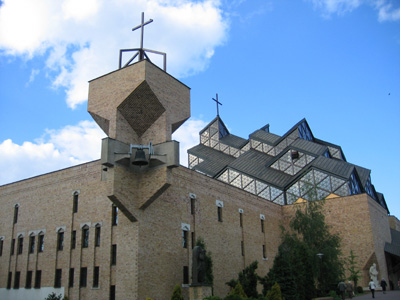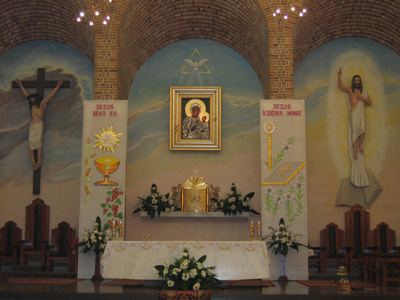 |
|

The church: Kosciol Zbawiciela (Church of Our Saviour), Nowa Huta, Krakow, Poland.
Denomination: Roman Catholic.
The building: A light, modern building.
The church: It seemed very thriving, with people of all ages.
The neighbourhood: Raised from scratch in the late 1940s on the site of an old village, the Nowa Huta district of Krakow was named after the nearby steelworks. Most people see the area as an ugly addition to an otherwise unspoilt city, but the area has lovely, planned open spaces and nicely kept appartment blocks. Nowa Huta was one of the epicentres of Solidarity-era opposition to communist rule. The communists did not allow any churches to be built until the 1970s. Since then, churches have sprung up all over the place.
The cast: No names were given.
The date & time: 1st May, 2004, 6.00pm.
Mszw Swieta (Holy Mass).
How full was the building?
Packed – I estimated about 1,000 people. I wondered what had drawn so many people to church on a Wednesday evening.
Did anyone welcome you personally?
No.
Was your pew comfortable?
Yes.
How would you describe the pre-service atmosphere?
Reverent, but bustling with anticipation.
What were the exact opening words of the service?
I don't speak Polish but the mass is the mass, in whatever language, so I assume "In the name of the Father and of the Son, and of the Holy Spirit."
What books did the congregation use during the service?
None.
What musical instruments were played?
Organ.
Did anything distract you?
The variety of vestments and costumes. There were five concelebrants in red chasubles. The cantor wore a cotta over brown trousers – no cassock. And there were several women dressed in Polish national costume, whose role (as well as the reason why the church was so full) was to become clear.
Was the worship stiff-upper-lip, happy clappy, or what?
Devotional, as only the Polish know how. The mass was celebrated at quite a pace. Some prayers were intoned, others said, but it felt as if every word was prayed. There was a mixture of formality and informality. For example, during the eucharistic prayer a boy, aged about eight, approached the altar in jeans and trainers to help one of the servers. He rang a small bell while one of the older, robed altar boys rang larger bells. After the consecration, he genuflected and left the sanctuary. That simple participation means a lot to younger people. Truly it does not require a lot of effort to find ways of involving people in worship.

Exactly how long was the sermon?
6 minutes.
On a scale of 1-10, how good was the preacher?
His style seemed very relaxed, but as I don't understand Polish I can't give him a rating.
In a nutshell, what was the sermon about?
No idea.
Which part of the service was like being in heaven?
At the end of the mass, the women in national costume picked up a statue of Our Lady and processed down the aisle. Next came little girls dressed in white with circles of flowers in their hair. They carried baskets of flowers which their mothers had brought in earlier in plastic bags. Finally came the priests carrying the Blessed Sacrament in procession under a canopy whilst the girls scattered flowers in the way. The procession exited the church and wound around the grounds, through a basketball pitch and back into the church again for benediction. By now I had realised that this was the octave of Corpus Christi (and was also May Day); indeed, I saw girls in white carrying flower baskets the next day, going to another church. I assumed this must be a custom that has survived in Poland more than elsewhere.
And which part was like being in... er... the other place?
Musing to myself how secular and Protestant England has become and wishing such devotional, heart-felt and well-attended services were available back home.
What happened when you hung around after the service looking lost?
Nothing. People streamed out of the church to go home.
How would you describe the after-service coffee?
There was none.
How would you feel about making this church your regular (where 10 = ecstatic, 0 = terminal)?
9 – It seems to be quite a centre of community.
Did the service make you feel glad to be a Christian?
Yes – though not particularly fond of the cold-hearted, cerebral Anglican part to which I belong. Catholics rule!
What one thing will you remember about all this in seven days' time?
The boy in trainers ringing the sanctus bell.
| The Mystery Worshipper is sponsored by surefish.co.uk, the internet service provider from Christian Aid. By offering email services, special offers with companies such as amazon.co.uk and smile.co.uk, surefish raises more than £300,000 a year for Christian Aid's work around the world. Click here to find out how to become a Mystery Worshipper. And click here if you would like to reproduce this report in your church magazine or website. Top | Other Reports | Become a Mystery Worshipper! © Ship of Fools 2005 |